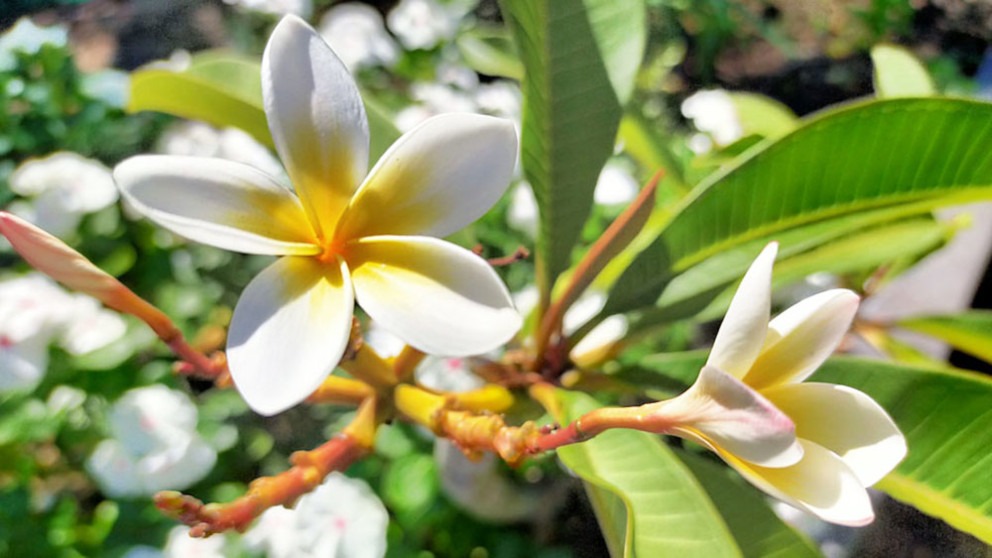If you’re like me, one of the best parts of a garden is its seclusion and private charm—a place to retreat from the world and relax in nature. However, not all yards and spaces are set up this way. Maybe you have a low fence, or perhaps you have neighbours overlooking your property. Today, I want to showcase some plants that are perfect for creating privacy and natural screens in the garden.
What Are Good Plants for Privacy?
Our ideal privacy plants are fast-growing and tall, making them perfect for quickly filling gaps and providing effective screening. Most of these plants are low-maintenance and drought-tolerant, although there will be a few exceptions in the list.
1. Golden Cane Palm (Dypsis lutescens)
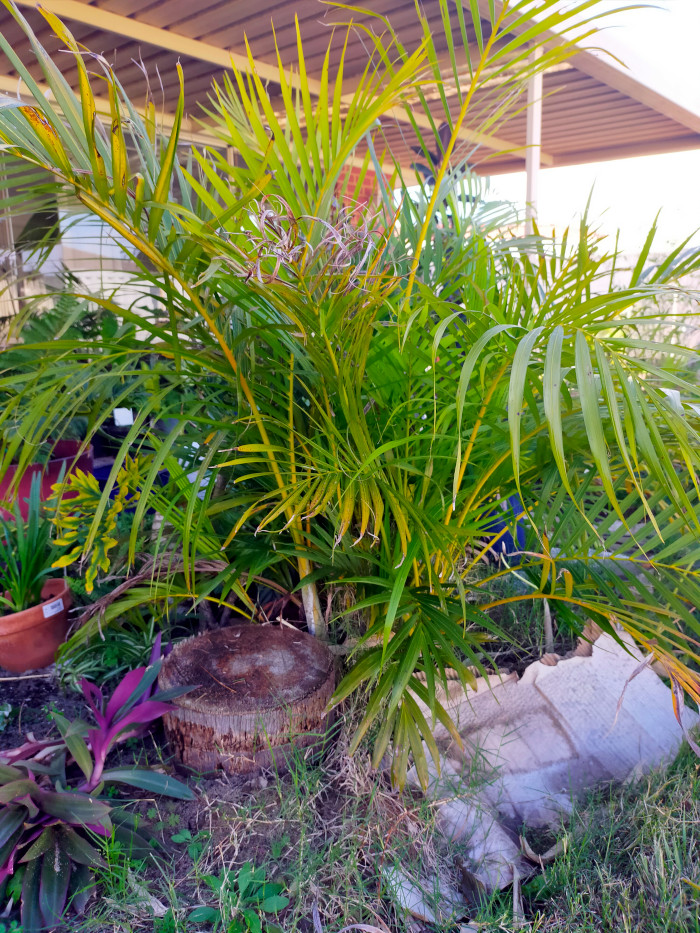
The golden cane palm (Dypsis lutescens) is a hardy, clumping palm that’s one of my favourites and is great for adding privacy to a yard, especially when young. As it matures, it spreads out, so planting multiple palms close together creates a denser screen. Once established, it’s quite drought-tolerant and low-maintenance, making it a good choice if you’re in a warmer, sunnier climate.
I’ve probably got ten or so planted around my yard, so I’m definitely an advocate for them. Their root systems are very small and non-invasive, so they’re safe to plant near foundations and irrigation systems.
Key Characteristics
- Height: 1.8 to 3.7m (6 to 12ft)
- Light: Full sun to partial shade
- Watering: Moderate; allow soil to slightly dry
- Soil: Well-drained, sandy soil
- Toxicity: Non-toxic to pets and humans
2. Clumping Bamboo (Fargesia robusta)
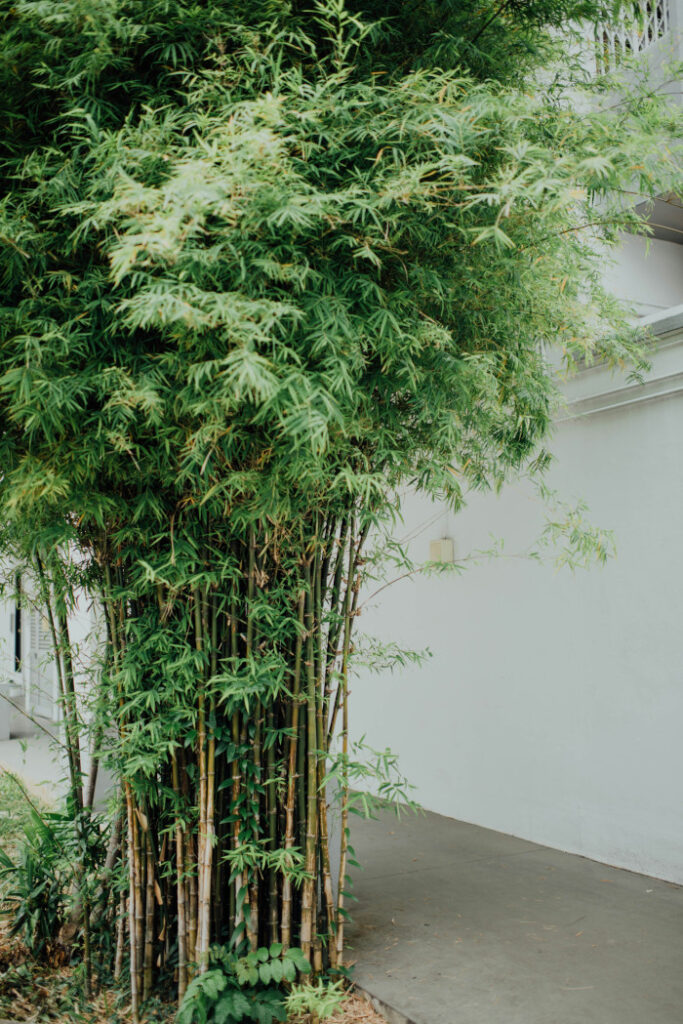
Known for its fast growth and dense compact stems, Bamboo is a classic choice when it comes to quickly creating a privacy screen. It does tend to drop leaves frequently and generally needs more regular watering compared to other plants, making it higher maintenance than others on the list. Be sure to choose a clumping variety, as running bamboo can be invasive due to their underground rhizomes that spread.
They come from tropical areas where the soil is quite rich and fertile so be sure to give them good quality compost to keep them happy and help them maintain moisture.
Key Characteristics
- Height: 3 to 5m (10 to 16ft)
- Light: Full sun to partial shade
- Watering: Moderate to high; needs consistent moisture
- Soil: Well-draining, loamy soil
- Toxicity: Non-toxic to pets and humans
3. Pittosporum (Pittosporum tenuifolium)
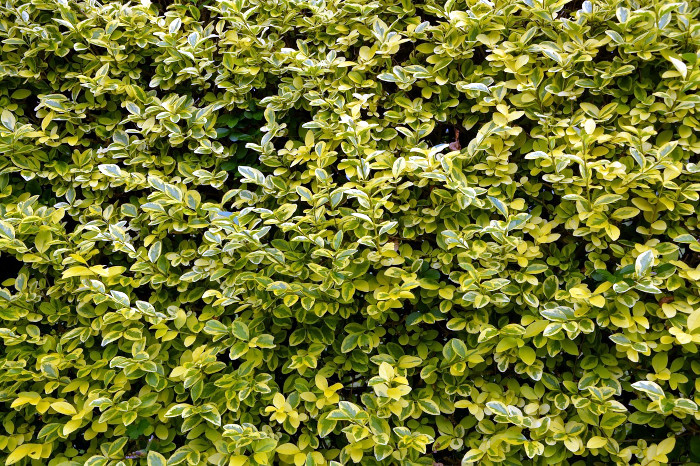
It seems everybody in my neighborhood grows Pittosporum and for good reason. Their lime-colored foliage is quite distinct and interesting compared to a lot of other hedging plants. They are very hardy once established, and I find their small, delicate branches and foliage easy to trim and maintain as a hedge.
Pittosporum is also quite versatile, thriving in a range of soil types and adapting well to both sun and partial shade. Another benefit is that it’s relatively drought-tolerant once established, making it a low-maintenance option for garden hedges.
Key Characteristics
- Height: Up to 3-5m (10-16ft)
- Light: Full sun to partial shade
- Watering: Moderate; tolerates periods of drought once established
- Soil: Well-draining soil, prefers slightly acidic to neutral pH
- Toxicity: Non-toxic to pets and humans
4. Viburnum (Viburnum odoratissimum)

With its dense growth and beautiful fragrant flowers, viburnum is a classic privacy plant. In my experience, it’s a bit less hardy than other plants on the list, and if you’re in a sunny climate, it could benefit from a little afternoon shade. Its dark, glossy foliage adds a lush, tropical feel to any yard, making it perfect for creating a more exotic look. Viburnum is also relatively low-maintenance once established and can be pruned to maintain shape and size.
Key Characteristics
- Height: 3 to 4.5m (10 to 15ft)
- Light: Full sun to partial shade
- Watering: Moderate; drought-tolerant once established
- Soil: Well-draining, loamy soil
- Toxicity: Non-toxic to pets and humans
5. Lily pilly (Syzygium paniculatum)

Here in Australia, the lily pilly (Syzygium species) is a classic choice for hedging. This native plant grows very quickly and is extremely drought-tolerant once established, making it ideal for Australian gardens. It can grow very tall, very quickly, providing excellent privacy, and produces small, edible fruits with a tart, apple-like flavour.
Key Characteristics
- Height: Up to 5m (16ft) or more, depending on the variety
- Light: Full sun to partial shade
- Watering: Low to moderate; drought-tolerant once established
- Soil: Well-draining soil, adaptable to various soil types
- Toxicity: Non-toxic to pets and humans
I planted this plant along my back fence as a hedge, and it worked great as a privacy plant to grow on a fence.
6. Photinia (Photinia × fraseri)
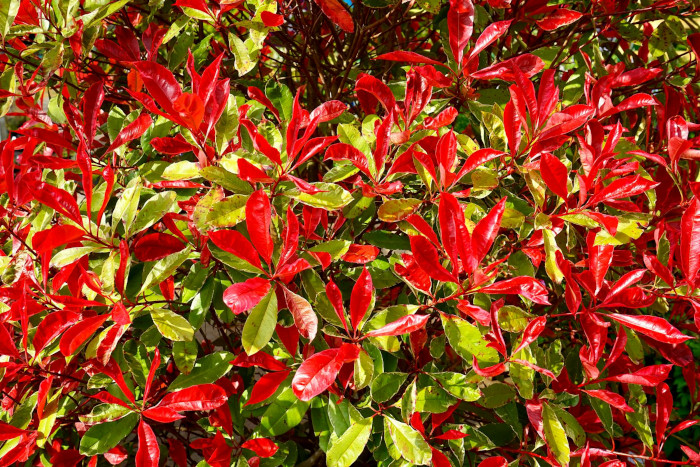
Photinia is a popular choice for hedges and screens with its eye catching red colour. It’s fast-growing but can be trimmed into a hedge quite easily to maintain its shape and size. It’s tolerant of a variety of climates both hot and cold making it quite a flexible choice. In spring, it produces small white flowers that attract pollinators which are great for your garden.
Key Characteristics
- Height: Up to 3-5m (10-16ft)
- Light: Full sun to partial shade
- Watering: Moderate; tolerates periods of drought once established
- Soil: Well-draining soil, prefers slightly acidic to neutral pH
- Toxicity: Non-toxic to pets and humans
7. Tiger Grass (Thysanolaena maxima)
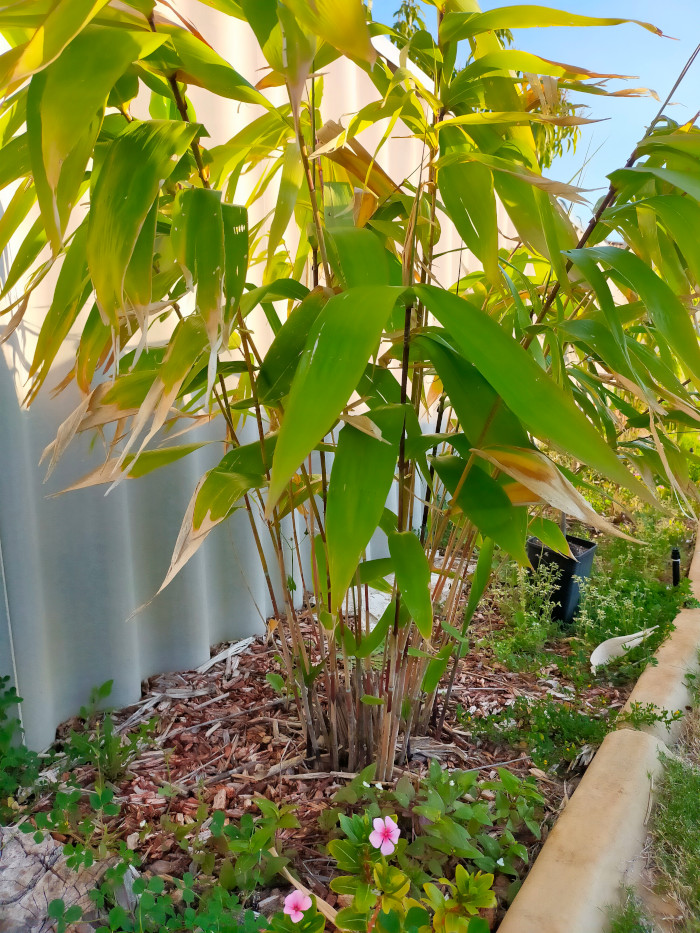
Tiger grass (Thysanolaena maxima) looks like bamboo but isn’t related. It’s a fast-growing, drought-tolerant plant that works well as a privacy screen. As it gets taller, it may start to lean, but it can be easily staked and gently tied with thin wire to keep it upright and bundled.
If it starts looking too messy for your liking, you can cut it down to the ground, and it will grow back quite quickly. Its dense foliage provides excellent coverage, making it a popular choice for creating natural barriers in tropical or subtropical gardens.
Key Characteristics
- Height: 1.2 to 3.0m (4 to 10ft)
- Light: Full sun to partial shade
- Watering: Moderate; drought-tolerant once established
- Soil: Well-draining, loamy soil
- Toxicity: Non-toxic to pets and humans
8. Bougainvillea (Bougainvillea glabra)
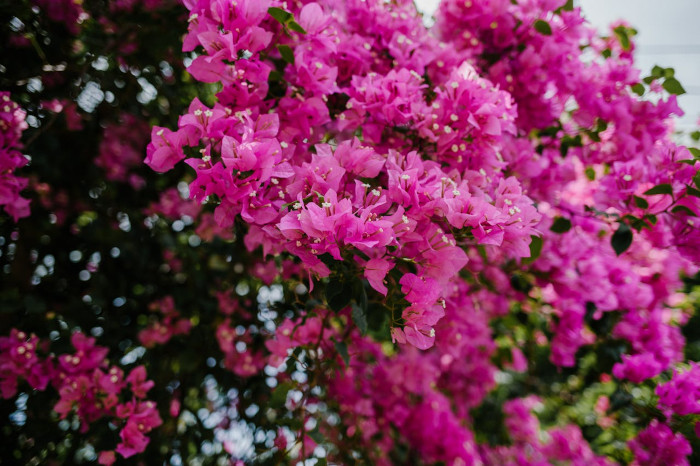
Bougainvillea comes in many vibrant colours and is a vigorous, hardy plant ideal for warmer climates. Due to its size, it’s often grown along fences or in corners of yards. Bougainvillea features large thorns similar to those of a lemon tree, adding a level of security when grown along a fence line. However, its main appeal is its stunning, colourful foliage, which will bring a mass of colour to any yard.
Key Characteristics
- Height: 1.2 to 3.0m (4 to 10ft)
- Light: Full sun
- Watering: Moderate; drought-tolerant once established
- Soil: Well-draining, slightly acidic soil
- Toxicity: Generally non-toxic to pets and humans
9. Orange Jessamine (Murraya paniculata)
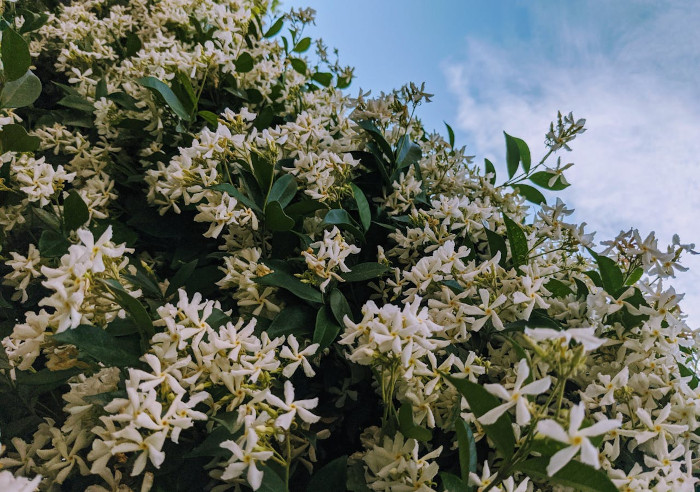
If you’re looking for a beautiful privacy plant with a lovely fragrance, orange jessamine (Murraya paniculata) is a perfect choice. Its white flowers have a pleasant, vanilla-like scent. This versatile plant can be grown as a tree, large bush, or pruned into a hedge, making it adaptable to whatever level of privacy you’d like to create.
It’s fast-growing and thrives in warm climates, making it a good choice for growing if you’re in a hotter region. Once established, it’s drought-tolerant, requiring minimal maintenance—especially if you let it grow naturally into a bush or tree.
Key Characteristics
- Height: 1.2 to 3.0m (4 to 10ft)
- Light: Full sun to partial shade
- Watering: Moderate; drought-tolerant once established
- Soil: Well-draining, loamy soil
- Toxicity: Non-toxic to pets and humans
10. Geisha Girl (Duranta erecta)
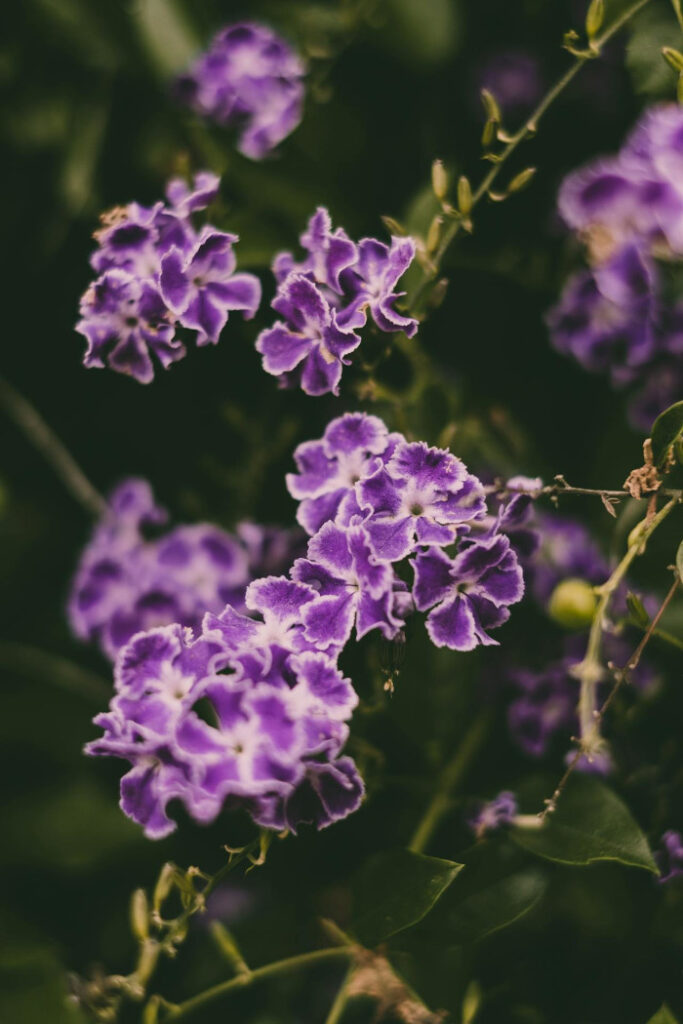
Geisha Girl, one of my favourites, is a variety of Duranta that can grow as a tree or a large bush. Its rich, dark purple flowers bloom densely, adding a vibrant pop of colour to any garden. The mass of flowers is great for attracting pollinators and birds to your garden.
Hardy once established, this plant thrives in full sun and adapts to a range of well-draining soils. It’s also a fast grower; in my experience, you can have a sizeable bush within three years. However, be mindful that its berries are poisonous, so care should be taken if pets or children frequent your garden.
Key Characteristics
- Height: 1.2 to 3.0m (4 to 10ft)
- Light: Full sun to partial shade
- Watering: Moderate; drought-tolerant once established
- Soil: Well-draining, loamy soil
- Toxicity: Berries are poisonous to pets and humans
11. Hibiscus (Hibiscus spp.)

Hibiscus is a sun-loving plant with dense foliage and vibrant flowers that attract bees, making it perfect for inviting pollinators into your garden. With many cultivars available, you can choose from different colours and heights, ranging from 1 to 3 meters.
While hibiscus needs more frequent watering compared to plants like bougainvillea, it is relatively low-maintenance once established and can tolerate a variety of soil types, though it prefers well-draining, slightly acidic soil. Regular pruning helps maintain its shape and encourages more blooms throughout the growing season.
Key Characteristics
- Height: 1.2 to 3.0m (4 to 10ft)
- Light: Full sun to partial shade
- Watering: Moderate; slightly higher water needs than some drought-tolerant plants
- Soil: Well-draining, loamy soil
- Toxicity: Non-toxic to pets and humans, though some people get skin rashes from handling the plant.
12. Leyland Cypress (Cupressus × leylandii)
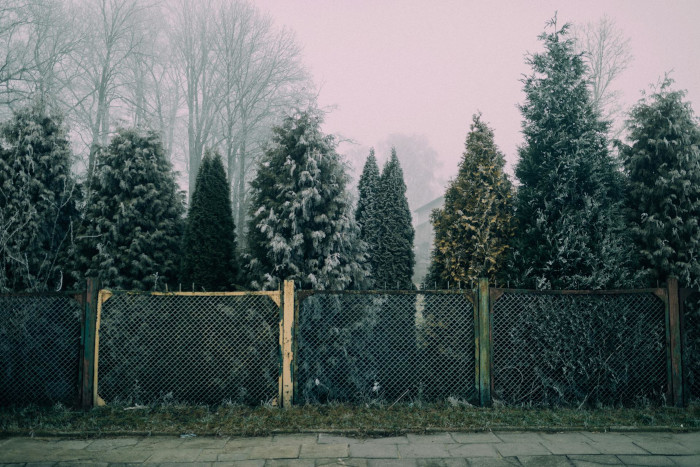
With its rapid growth and dense, evergreen foliage, the Leyland Cypress is a classic both here and abroad. It’s a good choice if you’re looking for a quick solution to create a solid screen, but it needs a decent amount of space to reach its full potential. Keep in mind that while it’s low-maintenance, it may need some regular trimming to keep it looking its best.
Key Characteristics
- Height: 15 to 20 meters (50 to 65 feet)
- Light: Full sun
- Watering: Moderate; drought-tolerant once established
- Soil: Well-draining soil, adaptable to various soil types
- Toxicity: Toxic to pets if ingested
Privacy Plants in Pots
Growing plants in pots can be a great way to create privacy. You can move them around at different times of the year when other parts of the garden become more sparse, and the contained roots help keep growth under control, allowing you to grow larger plants.
You can group potted plants together to create a screen or place them strategically around pools, patios, or balconies. Alternatively, you can use hanging pots to add privacy while thickening up your garden area, making it feel more lush and secluded.
In my experience, golden cane palms, clumping bamboo, and bougainvilleas look great and work well in pots. They will provide both privacy and style to any party of the garden with their lush foliage. Just keep in mind to use a larger pot size for these larger plants and that in hot climates, pot plants dry out faster than plants in the soil.
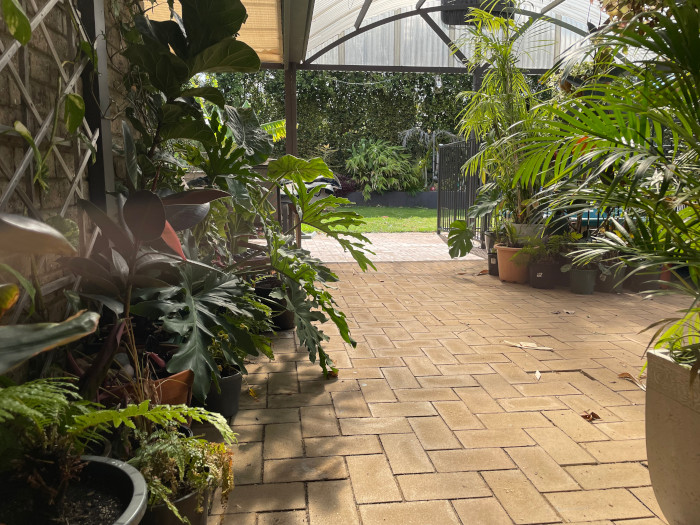
I’m a big fan of using pots in the garden. They’re incredibly versatile—you can use them to hide unsightly objects or walls or, as in this case, create a bit of privacy around an outdoor spa.
Conclusion
There are a lot of options for creating privacy with plants in your garden whether that’s a formal hedge, some trees or adding some larger shrubs around the place.
Many of the options on this list are low-maintenance and drought-tolerant once established, making them perfect long-term solutions. Just be sure to consider their size, growth rate, and any potential toxicity to pets before planting. With the right choice, you can enjoy a beautiful, private garden space for years to come.
